A new port on my list as I had never been here. Not a difficult port as such, the dock is just around the corner from Cook Inlet and shielded to a certain extent from the currents. It is not shielded from the winds as the area is completely flat and open. It cannot be cozy over there in the winter time. The Statendam arrived nice and early giving the guests some extra time ashore.
I always had the impression that Homer was a sleepy fishing town at the edge of the Gulf of Alaska. Today I saw a traffic jam caused by SUV’s and Pickup Trucks. If you are into Pick-up trucks for a hobby then this is the place to be, I never saw so many variations in my whole life. All by owners who come here for the fishing. Rows and Rows of cars, pickup trucks and RV’s (from small ones to the big ones that set you back at least a $ 100,000 or more.)
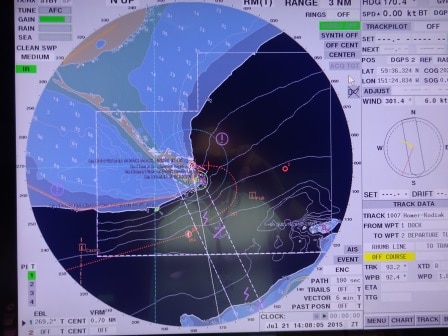
The Spit. A large sandbank sticking out from the mainland. The Statendam docked at the end, where the deep water harbour is.
Basically the area is split up in two parts. I read it in the daily program and when I went ashore I understood why. There is Homer itself, laid back from the port and there is “the Spit” where all these fishing people gather. Holland America had of course its own tours going but there was a local shuttle service as well, in School buses. Another first in my life, I have never sat in an American school bus before and it directly puzzled me. Why are those back seats so high? I am 5’8’’ and I could just look over the rim of the seat in front of me.
The school bus – shuttle had two options, one called the hop on hop off which went around Homer itself and cost $ 15, — and the free shuttle to “the Spit”. As I wanted to know what all these parked cars were about, which I could see from the bridge, I hopped on the free shuttle and then found out about the fishing.
“The Spit” is basically a tourist area full of fishing restaurants, a few tourist shops and some regular shops geared towards the fisherman. With so many people coming in, these places do a thriving business even if they are located at the end of the world.
Two of the restaurants offered “real Fish and Chips” and to outdo each other, one restaurant gave you the option to eat your fish and chips in a Real English London Double Decker, a Roadmaster bus. I wonder how they got that one all the way from London to Homer.
To really understand this place, I had to look it up. We have an excellent Location Guide on board, her name is Wallis, but I have had no time yet to attend her presentations so I have to make do with Wikipedia. The Spit is a piece of land protruding from the mainland and that makes it quite convenient to have a marina there and a deep water harbor so that larger ships can dock as well.
Today we had the Statendam and an Alaskan State Ferry in port. It also claims to have the longest road in the world leading out into Ocean.
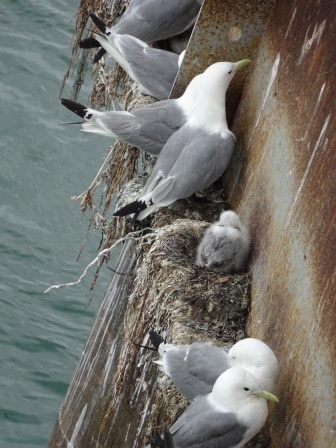
I am not an ornithologist, so if anybody knows what the real name of the little sea gulls is, please let me know.
Sticking out so far into the sea makes it a natural place for Sea Gulls (small version) to live and many were nesting on the foundation of our pier. As Seagulls are normally not potty-trained the smell is rather distinctive when you come off the ship and only relents by the time you come to the parking area. We had a sunny but chilly day today and I think that the guests really enjoyed themselves and this is a really interesting place to visit. I was glad that I made the effort to go ashore. Homer itself will have to wait until I call here again.
My day was spent training all the Concessions (Shops, Casino, Ocean Spa) etc. in how to be a proper Stairway Guide. The crew you see giving directions in the staircases during boat drill. My main focus is on Crowd Control and Human Behavior so they learn how to deal with guests during a real emergency and not just during the regular passenger boat drill routine.
We sailed just after 18.00 hrs. and we are now heading to Kodiak. Kodiak is located on Kodiak Island just south of the entrance to Cook Inlet. The weather is holding and we are supposed to have another sunny day or at least a dry day. Temperatures are supposed to be in the low sixties’.
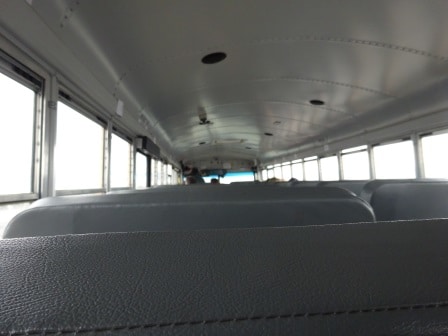
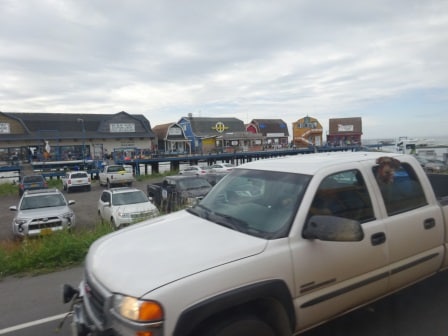
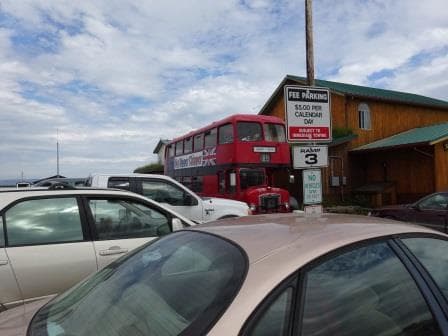
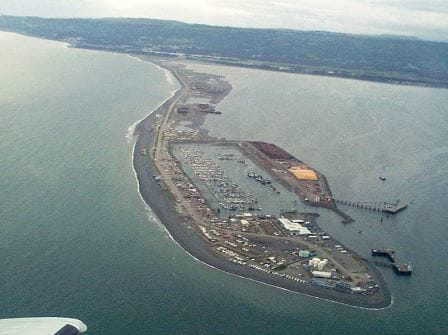
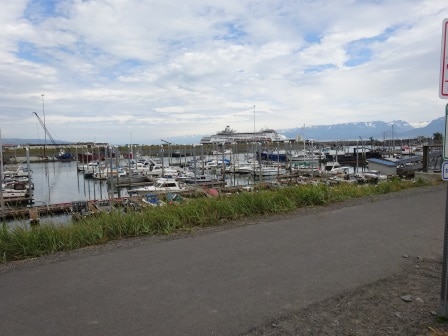

July 22, 2015 at 7:01 pm
Hello Captain,
We have met a few times at Ocean Liner Society meetings in London, and on the OLS visit to the Prinsendam some years ago. Interested to read all your posts about Alaska as we are thinking of a cruise there next year.
The double decker bus you showed in your photo actually does not look like a London Routemaster. I think it is a Bristol Lodekker, built, I believe, for use in country districts where bridges over the roads are lower. The whole vehicle is therefore not so high as a London bus where clearances are greater.
Best wishes,nope to see you again at a meeting sometime when you are on leave.
Philip Hall
July 23, 2015 at 11:50 am
Thank you,
I am totally ignorant as far as buses are concerned, I just like to ride them. But I looked at the Bonnet and it looked like a roadmaster.
For the OLS I have offered to do another lecture and gave about 10 options. Management is currently breaking their head about which one to choose
Thank you for reading my blog
Capt. Albert
July 22, 2015 at 7:14 pm
Regarding the little gulls. I am not an ornithologist either, but birding is my hobby and I believe those birds might be black-legged kittiwakes. I can’t really see if they have black legs, so I am offering my best guess. Perhaps one of your other loyal readers will offer another opinion. Black-legged kittiwakes are widespread and nest in northern climes on both the Atlantic and Pacific coasts. Thanks for your interesting blogs. I think I will need to sign up for that Alaska cruise out of Seattle, even though I live in Vancouver.
July 23, 2015 at 11:48 am
Yes,
they did have black feet. At least most of them had. so you are probably right.
Thank you for answering and reading my blog.
Capt. Albert
July 23, 2015 at 2:50 am
Regarding your comment about school bus seats, the following is from the web site of the US National Highway Traffic Safety Administration:
Federal motor vehicle safety standard No. 222, “School Bus Passenger Seating and Crash Protection” requires that the interior of large buses provide occupant protection so that children are protected without the need to buckle-up. Occupant crash protection is provided by a protective envelope consisting of strong, closely-spaced seats that have energy-absorbing seat backs. … Generally they fit three smaller elementary school age persons or two adult high school age persons into a typical 39 inch school bus seat.
Basically, the high seat backs help protect occupants (by keeping them contained in the seating area after a sudden stop or sudden forward acceleration) without requiring them to wear seat belts.
July 23, 2015 at 11:46 am
Thank you,
I wonder why there were no safety belts in the Bus, as in Europe this is standard practise, also on school buses. I can see that the high seat will act as a bumper.
Thank you for reading my blog and answering my query.
Capt. Albert
July 28, 2015 at 10:33 pm
Thanks for the blog. We’re on our first Alaska trip on the Westerdam this Saturday. The operational info adds to my building interest!